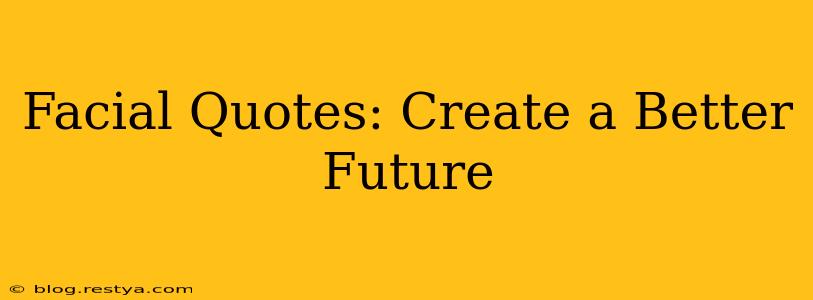Facial Quotes: Creating a Better Future Through the Power of Expression
Have you ever stopped to think about the power of a smile? A simple upturn of the lips can brighten someone's day, diffuse a tense situation, or even forge a connection across cultures. Facial expressions, the silent language of humanity, are far more than just muscle movements. They're a potent force, capable of shaping our interactions, influencing our emotions, and even contributing to a better future. This isn't just about pretty pictures or social media trends; it's about understanding the profound impact of facial communication and harnessing its potential for positive change.
This article delves into the multifaceted world of facial expressions, exploring their significance in communication, emotional regulation, and even societal progress. We'll unpack the science behind facial cues, examine the role they play in building empathy, and discuss how a deeper understanding of facial quotes – the unspoken messages conveyed through our faces – can lead to a more compassionate and connected world.
What are the different types of facial expressions and what do they mean?
This is a fundamental question that touches upon the core of human interaction. Understanding the nuances of facial expressions is crucial for effective communication. We're not just talking about basic emotions like happiness, sadness, anger, fear, surprise, and disgust (the universally recognized six). Micro-expressions, fleeting changes in facial muscles, can reveal hidden emotions. A subtle tightening of the jaw, a fleeting furrow of the brow, a quick flash of the eyes – these subtle shifts can betray underlying feelings that words may conceal. Learning to read these expressions requires practice and observation, but it dramatically enhances our ability to understand others. Think of it as learning a new language, one that speaks volumes without uttering a single word.
How do facial expressions influence our emotions?
The connection between facial expressions and emotions is a two-way street. What we often overlook is that the very act of making a certain facial expression can influence our emotional state. The famous "facial feedback hypothesis" suggests that mimicking a happy expression, for instance, can actually make us feel happier. This is not mere suggestion; studies have shown a physiological connection between facial muscles and emotional experience. This understanding has huge implications for mental well-being. Consciously engaging in positive facial expressions, such as smiling or expressing gratitude, can help regulate our emotions and boost our mood. It's a simple yet powerful technique for improving mental health.
How can we improve our ability to read facial expressions?
Improving our ability to "read" facial expressions is a skill that can be honed with practice and awareness. Start by paying close attention to the faces of people around you. Observe not just the major expressions, but also the subtle nuances. Look for inconsistencies between verbal and nonverbal cues – often, the face will reveal the truth even when words offer a different story. Furthermore, actively practice mimicking expressions. Try to replicate a particular emotion on your own face to better understand the underlying muscle movements. There are also resources available, such as online courses and workshops, dedicated to improving facial expression recognition. This is not just a social skill; it's a vital component of empathy and effective communication.
How can understanding facial quotes help us build better relationships?
Building strong, healthy relationships relies heavily on effective communication, and understanding facial expressions is a cornerstone of that communication. When we can accurately interpret the facial cues of others, we demonstrate empathy and understanding, making them feel seen and heard. This, in turn, fosters trust and strengthens bonds. By recognizing the unspoken messages conveyed through facial expressions, we can respond more appropriately, offering support when needed, defusing conflicts before they escalate, and building stronger, more meaningful connections. Consider the simple act of noticing a friend's worried brow; a quick inquiry about their well-being can make a world of difference.
What is the role of facial expressions in building a more empathetic society?
In a world often characterized by division and misunderstanding, the ability to understand and respond to facial expressions is crucial for building a more empathetic society. By fostering emotional literacy, we increase our capacity for compassion and understanding. When we recognize the emotional states of others through their facial expressions, we are better equipped to respond with kindness and support. This contributes to a more inclusive and harmonious environment, where differences are respected and individuals feel valued. It's a small step, but it's a significant one in bridging gaps and promoting social cohesion.
In conclusion, the seemingly simple act of observing and interpreting facial expressions has profound implications for our personal lives and the world around us. "Facial quotes," the unspoken messages etched on our faces, hold immense power. By understanding and utilizing this silent language, we can foster stronger relationships, improve our emotional well-being, and contribute to a better, more empathetic future for all.

